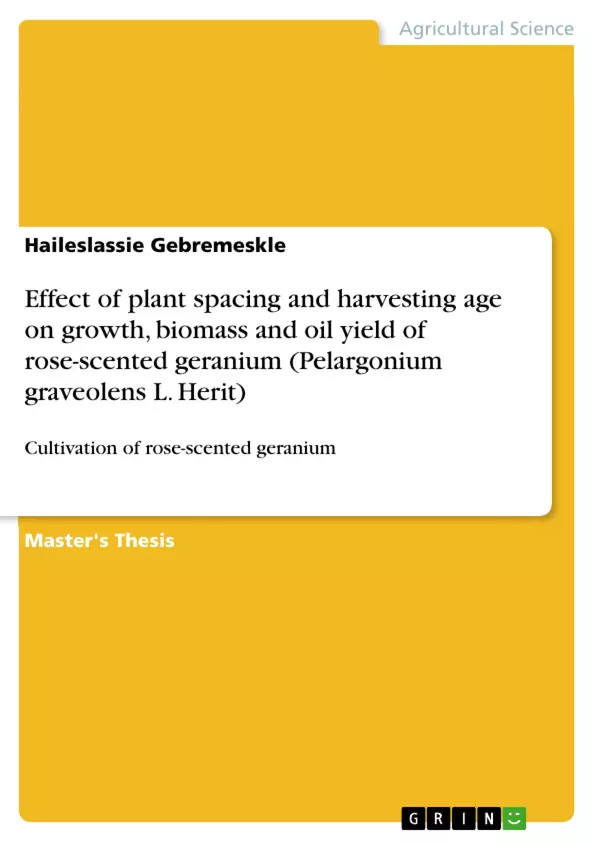In order to investigate the effect of plant spacing and harvesting age on growth, biomass and oil yield of rose-scented geranium; a study was carried out at the research field of Wondo Genet Agricultural Research Center in the 2013/14 cropping season. The study was a 4 x 5 factorial combination based on randomized complete block design (RCBD) with three replications. The experiment was consisted of four levels of plant spacing (30 x 30, 30 x 40, 30 x 50 and 30 x 60 cm, which result in 111111, 83333, 66666 and 55555 plants/ha, respectively) and five levels of harvesting age (90, 105, 120, 135 and 150 days after transplanting (DAT)). Main effects of plant spacing and harvesting age significantly influenced plant height, number of internodes, internodes length, leaf area and dry leaf weight/plant. While interaction effect of the two factors significantly influenced number of branches/plant, number of leaves/plant, leaf area index, fresh leaf weight/plant, aboveground biomass/ha, fresh leaf yield/ha, dry leaf yield/ha, dry stem yield/ha, harvest index, essential oil content and essential oil yield/ha. The finding revealed that higher number of branches and leaves were recorded at 30 x 60 cm spacing combined with 90 and 135 DAT and higher leaf area, dry leaf weight and fresh leaf weight were recorded at 30 x 60 cm along with 120, 135 and 120 DAT, respectively. At 30 x 30 cm spacing combined with 150, 120 and 150 DAT, highest plant height, leaf area index and number of internodes were obtained; while, the highest aboveground biomass, fresh leaf yield, dry stem yield and dry leaf yield were produced at 30 x 30 cm spacing with 120, 135, 150 and 135 DAT, respectively. Significantly higher essential oil content and harvest index were produced at the treatment combination of 30 x 40 cm spacing when harvested at 90 DAT. On the other hand, the essential oil yield (21.01kg/ha) at 30 x 30 cm plant spacing when harvested at 135 DAT was relatively higher than those of all treatment combinations, which, however it did not statistically different with that of 30 x 30 cm combined with 120 DAT (20.87 kg/ha). In total, it can be recommended to use 30 x 30 cm spacing level with harvesting age of 120 to 135 DAT for essential oil yield production at Wondo Genet area.
Table of Contents
- Introduction
- Review of Literature
- Materials and Methods
- Study Site
- Plant Materials
- Experimental Design and Treatments
- Data Collection
- Plant Height
- Number of Branches
- Leaf Area Index
- Biomass Yield
- Essential Oil Yield
- Essential Oil Composition
- Data Analysis
- Results and Discussion
- Effect of Plant Spacing on Growth and Biomass Yield
- Effect of Harvesting Age on Growth and Biomass Yield
- Effect of Plant Spacing and Harvesting Age on Essential Oil Yield
- Effect of Plant Spacing and Harvesting Age on Essential Oil Composition
- Conclusion
- Recommendations
- References
Objectives and Key Themes
The main objective of this research was to investigate the effects of plant spacing and harvesting age on the growth, biomass and essential oil yield of rose-scented geranium (Pelargonium graveolens L. Herit). This study aimed to identify optimal planting distances and harvest times for maximizing geranium yield and oil quality. The study was conducted at the Wondo Genet Agricultural Research Center in Ethiopia.
- Influence of plant spacing on geranium growth, biomass, and oil yield.
- Impact of harvesting age on geranium growth, biomass, and oil yield.
- Combined effects of plant spacing and harvesting age on geranium essential oil yield and composition.
- Determination of optimal planting distances and harvest times for maximizing geranium production.
Chapter Summaries
- Introduction: This chapter provides background information on the importance of rose-scented geranium as a source of essential oils, highlighting its economic and medicinal value. It also discusses the significance of optimizing plant spacing and harvesting age for maximizing geranium yield and oil quality.
- Review of Literature: This chapter presents a comprehensive review of existing literature on the cultivation and essential oil production of rose-scented geranium. It summarizes previous studies on the effects of plant spacing, harvesting age, and other factors on geranium growth, biomass, and oil yield, and discusses the chemical composition of geranium essential oils.
- Materials and Methods: This chapter details the experimental design, plant materials, study site, data collection methods, and statistical analysis techniques used in the research. It describes the experimental setup, plant spacing and harvesting age treatments, growth measurements, essential oil extraction methods, and data analysis procedures.
- Results and Discussion: This chapter presents the results of the experiment, including the effects of plant spacing and harvesting age on growth, biomass, oil yield, and oil composition. It discusses the findings in relation to previous research and provides insights into the factors influencing geranium production.
Keywords
The primary keywords and focus topics of this research include rose-scented geranium, Pelargonium graveolens, plant spacing, harvesting age, growth, biomass, essential oil yield, essential oil composition, Citronellol to Geraniol ratio, and agricultural research.
- Citation du texte
- Haileslassie Gebremeskle (Auteur), 2015, Effect of plant spacing and harvesting age on growth, biomass and oil yield of rose-scented geranium (Pelargonium graveolens L. Herit), Munich, GRIN Verlag, https://www.grin.com/document/288955



